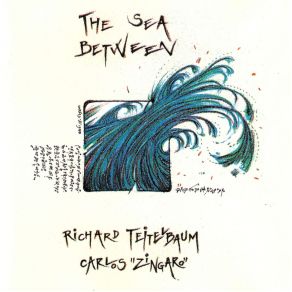The Sea Between
Download links and information about The Sea Between by Richard Teitelbaum, Carlos Zíngaro / Carlos Zingaro. This album was released in 1993 and it belongs to Electronica, Jazz, Avant Garde Jazz genres. It contains 6 tracks with total duration of 01:04:55 minutes.

|
|
|---|---|
| Artist: | Richard Teitelbaum, Carlos Zíngaro / Carlos Zingaro |
| Release date: | 1993 |
| Genre: | Electronica, Jazz, Avant Garde Jazz |
| Tracks: | 6 |
| Duration: | 01:04:55 |
| Buy it NOW at: | |
| Buy on iTunes $11.99 | |
Tracks
[Edit]| No. | Title | Length |
|---|---|---|
| 1. | Agora Nada (featuring Carlos) | 9:26 |
| 2. | The Sea Between (featuring Carlos) | 13:18 |
| 3. | The Structure #01 (featuring Carlos) | 1:39 |
| 4. | Sciences Humaines Op.03 (featuring Carlos) | 12:39 |
| 5. | The Ghosts Of Srebrenica (featuring Carlos) | 3:46 |
| 6. | Golem Sketches (featuring Carlos) | 24:07 |
Details
[Edit]In October 1987, keyboardist/computer wiz Richard Teitelbaum and violinist Carlos Zingaro performed at the Festival International de Musique Actuelle de Victoriaville. The next year the label Disques Victo released The Sea Between, comprised of three improvisations from that show. For the CD reissue in 1993, the label added 18 minutes of material in the form of three excerpts from a performance in Lisbon during November 1992. Playing with electronics — especially with computers — the danger here was the inevitable difference in the technology used over a six-year span. Surprisingly, it is not the case, even though overall there are more synthesizers in the later pieces. On "Golem Sketches," the two musicians play a game of call and response: Zingaro leads the way, first uttering short musical phrases that Teitelbaum refeeds immediately, transformed. The violinist quickly adapts, creating textures suitable to his partner's environment, only to be surprised by unexpected developments. It goes on for 24 minutes of playful hide and seek. "The Sea Between" and "Sciences Humaines Op. 03" call for a lusher synthetic environment and a more participative role from Teitelbaum. Alien aerial (yes, more airborne than seaborne) landscapes are sketched, and the music often gets close to Peter Frohmader or some electro-acoustic music for instrument and tape (Serge Arcuri or Paul Dolden, for example), except that this is a real-time interaction with a violinist acting as both responding improviser and provider of source material. "The Structure #01" and "The Ghosts of Srebrenica" don't bring much to the album, but the inclusion of "Sciences Humaines Op. 03" is a welcomed addition. ~ François Couture, Rovi